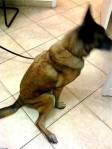If Your Dog Sits Funny, Get a Knee Check Up!
6-Year-old Belgian Malinois Police Dog Injures Cranial Cruciate Knee Ligament
Ashley ran the fence every night. She guarded the yard from the ominous strangers delivering pizza and walking their poodles on the other side of her fence.
One Spring night, suddenly, for no clear reason, Ashley started yelping and soul-wrenchingly howling in pain! She held her right hind leg up close to her tummy and limped back to the house, licking her lips on pain and anxiety.
Her handler/human father had no idea what could have happened!
“Doc, you gotta believe me, she howled so loud, me and my wife thought she got bit by a snake,” said the canine officer, “By the time she got to the back door of the house, she was putting a bit of weight on it. But I can tell it still just isn’t right.”
When a Dog Holds a Leg Up, Something’s Wrong!
When your dog holds a leg up, something is wrong. The only way your dog knows to deal with the pain is to hold the leg up, sometimes with just the toes touching the ground. Usually, running is easier than walking, turning, or especially, getting up from a down position. The slow movements are harder than the fast running. During running, the paws hardly touch the ground, and a dog can run just fine on three legs, and really never put any weight on the painful fourth leg.
“Many people are fooled by the easy running. They sense their dog may have an injury, but they are confused by the ability to run better than to walk. Do not hesitate to bring your dog to your veterinarian if there is severe limping, or limping for more than 24 hours,” says Doc Truli”
Sudden Limping On a Hind Leg Usually Means Knee Injury
Check your dogs paws and pads for cuts, stones, hair mats, cysts, ulcers, sores, bee stings, etc. Sometimes the problem is a laceration (expensive doctor word for a cut). Sometimes matted up fur knows in a clump and makes your dog feel like he or she is walking with a stone in the proverbial shoe.
If your dog will not touch one hind leg to the ground at all, go to the emergency room or your vet’s if they are open. Hip dislocation, fractures, and severe urgent problems make a dog completely stay off of a leg.
Most dogs limp and have a slight lameness called toe-touch lame, this means your dog will put weight on the leg sometimes, but leans heavily on the sound leg. Orthopedic surgeons tell us that 85% of hind limb lameness in dogs is attributable to knee instability. The patella and the cruciate ligaments are often to blame!
Your Dog Sits “Sloppy” With a Knee, or Both Knees Thrown Out to the Side
If your dog sits like the canine officer in the picture, with one or both legs out to the side, this is a sure sign of knee pain and dysfunction. Some dogs have had a sore knee most of their lives, and a slow degenerative process eats away at the stability of the knee, and the dog’s confidence and comfort.
Diagnosing Cruciate Ligament Injury
“Doc, what the heck is the cranial cruciate ligament?
What is This Cruciate Ligament of Which You Speak?
Inside the knee, under the kneecap, lives the cranial and caudal cruciate ligaments. These are the ligaments that professional athletes often rupture as they torque and pound on their knees during performance. They are x-shaped tough fibrous, somewhat elastic bands inside the knee in an X-shape. The X pattern helps these ligaments hold the knee from sliding too far forward or backward with each step. When the ligaments are not working, or have ripped, the femur (upper leg long bone) painfully grinds against the top of the lower leg tibia.
So That’s It? What Does My Veterinarian do to Diagnose this Injury?
Cranial Drawer Test
Your dog is asked or helped to lie on his or her side. Then, the veterinarian holds the affected leg in an extended straight position. With a finger on the patella (kneecap), and a hand on the tibia, the knee apparatus is moved front to back, and back to front. A normal knee exhibits no laxity during this Cranial Drawer Test. Think of a drawer sliding open and shut. There should be no drawer in the knee. If there is, there is probably a loose, stretched, or ripped ligament.
Tibial Thrust Test
Still in the side position, your veterinarian will do a Tibial Thrust Test. The hands are almost in the same place on the kneecap and the tibial crest in the front of the tibial. The tarsus (ankle) is help at a ninety degree angle and then flexed to a smaller, perhaps twenty degree angle, while the knee is held still. The knee-joint should stay solid. If a ligament is ripped, the tibial will thrust forward. Obviously, this test is painful in an abnormal knee. Some dogs need to wear a muzzle for this test so they do not bite when they feel the pain. If the test hurts a lot, or your dog is tense from anxiety, your veterinarian will administer sedatives to your dog (not you!).
Can X-Rays Help?
“Captain Morgan” Radiograph Position
Radiographs (X-Rays) may need to be obtained. An anesthetized, or relaxed sedated dog, is placed on his or her side, and knee radiographs are obtained. The knee and ankle are each bent in ninety degree angles. This means a nice right angle to the knee, and also to the ankle. Doc Truli calls this the “Captain Morgan” x-ray position because of the popular television ad campaign.
This position allows the laxity in the knee to be seen and measured. If a line is drawn through the center of the tibial in a properly positioned image, and the top comes out in front of the patella, instead of just behind the front of the patella, then there is excessive joint laxity.
Great. Now, What Can I Do About a Cruciate Injury in my Dog?
Surgery
Big Dog. Big laxity. Lots of pain. Or two knees injured at the same time. Or one hind leg missing in your dog. Surgery. There are many, and sometimes controversial, surgeries to change the physics of the knee to lessen laxity, or apply strong sutures to the sides of the knee to stabilize the joint. Consult with a recommended orthopedic veterinary surgeon. Choose a qualified, board-certified surgeon who has performed 100’s of procedures for the best results. The arguments for each type of surgery vary by country, training, surgeon’s preference, education opportunities, etc.
There are, however, no surgeries that successfully rebuild the natural ligaments in the dog. The biofeedback of the living ligament helps to make the joint what it is. Installing a cadaver ligament or an artificial fiber does not work anything like a living ligament. Researchers keep looking, however, because ligament regeneration or replacement would help humans with this same injury.
No Surgery
Small dog. Three other good legs. Mild to moderate pain. No harm in the “wait n see” approach. Pain control is a necessity. Non-steroidal prescription anti-inflammatory medication, opioids, Class IV Laser therapy, hydrotherapy, and physical therapy are all good options.
What Is Class IV Laser Therapy?
Well, I’m glad you asked! Class Four Laser therapy delivers infrared wavelengths in a certain frequency and time to make a dose that penetrates different thicknesses and compositions of body parts. (A knee is not the same as a paw, etc.)
The Laser Therapy has not been shown scientifically to help in knee instability. It help arthritis tremendously, but unstable is unstable. Unless you stabilize that joint by healing, exercise, and/or surgery, it may always cause pain.
The infrared heats the area, warming it and increasing blood circulation, which brings healing factors and feels relaxing.
The Class IV Laser also acts on local acupuncture points to release natural endorphins and help with pain control. Less pain means more healing and more ability to take part in physical therapy.
But even better, the Class IV Laser energy is absorbed by the cellular energy factories (mitochondria) that make the energy of life, ATP. These mitochondria use the infrared energy to make more ATP for healing, detoxification, and healing.
Therefore, the Class Four Laser has been shown to help sooth the joint cartilage surfaces, decreasing arthritis symptoms and pain.
Warning: Do not administer aspirin (old-fashioned remedy), as recent research shows aspirin always causes ulcers in dogs, at any dose. Also, do not give your painkillers. Many medications for humans, especially painkillers, kill dog’s livers. Get to your veterinarian or an emergency room.
If you absolutely live in the middle of nowhere, cold pack therapy within the first 24 hours of injury helps decrease the pain and inflammation.
Ashley Feels Better
In Ashley’s case, she’s taking her prescription medication, getting her laser treatments, and resting for 2-6 weeks. Probably, she’ll need knee surgery.
The lateral suture repair technique has an 85% chance of return to pet function, chasing the ball in the yard.
The TPLO (Tibial Plateau Leveling Osteotomy) procedure has an 85% chance of return to athletic function. As she is a working police canine officer, she need athletic function, which is probably not possible without surgery.
P.S. Cats get cruciate ligament injuries too! And they throw that leg out at a sloppy funny angle also!




Update: Ashley did not need knee surgery She limps for a few days every two months or so, but basically lives a full, complete life without the surgery. What a lucky dog!
How is she doing? Did she recover without surgery?
Hello “dog knee brace australia”-
I can see you responded to my article partly to connect to a possible customer audience. But I think your question brings up a useful teaching point.
The research for knee surgeries report “successful outcomes” for different surgical procedures. Lateral suture repair, TPLO and TTA surgeries all report “successful” outcomes. But their definitions of success are not the same as each other! The lateral suture repair definition of success is return to pet activities like chasing ball in the back yard. Return to function for TPLO and TTA surgeries was return to athletic performance. As the dog in the story was a working police dog, she underwent surgical repair of her stifle (knee).
Since I wrote this article, I became certified in acupuncture and herbal medicine for dogs. Electroacupuncture and herbal medicine offer integrative treatments for dogs with stifle ligament weaknesses with or without surgery. I also use braces and physical therapy for dogs with stifle ligament injuries. Additionally, a new product called Myos Veterinary formula has exciting research to show it helps maintain muscle mass in the affected leg even with strict rest after stifle surgery.
Bottom line: there are many treatment options for dog stifle injuries and a caring, trusted veterinarian must be consulted to help pet parents plan for their beloved pet. If a veterinarian is offering surgery, take a moment to ask about physical therapy, post-op care, muscle sparing, cartilage preservation, etc. If you are not getting answers, not that dog sports medicine and rehabilitation is now a board-certified veterinary specialty and you may have a referral option near you.